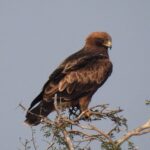The Booted Eagle (Hieraaetus pennatus) is a medium-sized bird of prey with a wide distribution in the Palearctic and southern Asia, wintering in the tropics of Africa and Asia. Its life cycle is a fascinating study of migration, breeding, and adaptation to various habitats.
The Booted Eagle’s Habitat and Distribution
The Booted Eagle breeds in southern Europe, North Africa, and across Asia, and also in western South Africa and Namibia. It prefers wooded, often hilly areas of the countryside with some open spaces, and breeds in rocky, broken terrain. Migrants, however, tend to use almost any kind of habitat other than dense, thick forested areas.
Breeding and Nesting Behavior
 Image source: Booted eagle By Dr. Raju Kasambe
Image source: Booted eagle By Dr. Raju Kasambe
Booted Eagles are territorial and use elaborate aerial displays to establish a pair bond. Their courtship displays include very fast and marvelous stoops. They build their nests on a large branch of a tree or cliff ledge, 6-35 meters up, and lay 1-2 eggs. The eggs are incubated mostly by the female for 37-40 days before hatching. The chicks stay in the nest for up to 55 days, and the parents continue to feed them for several weeks after they leave the nest.
Feeding Habits
The Booted Eagle is a carnivorous bird, feeding on a wide range of animals including birds, small mammals, reptiles, rodents, amphibians, and insects. It hunts its prey by perching from a lookout or on the ground, or by soaring high above clearings and forest.
Migration Patterns
The Booted Eagle is a migratory bird, with northern populations spending the winter in Sub-Saharan Africa and South Asia, while the small southern African populations are sedentary.
Physical Characteristics
The Booted Eagle is the smallest Eagle species in Europe, with a wingspan of 11-132 cm and a length of 40 cm. Males weigh about 510-770 g (1.12-1.70 lb), and females about 840-1,025 g (1.852-2.260 lb). There are two relatively distinct plumage forms, with pale birds being mainly light grey with a darker head and flight feathers, and the other form having mid-brown plumage with dark grey flight feathers.
Conservation Status
The Booted Eagle is currently not globally threatened and is classified as of “Least Concern” by BirdLife international. However, many local populations in Europe are very small, which makes them vulnerable to changes, and so should be closely monitored. The biggest threat to Booted Eagles is currently the destruction of their favored habitat, which includes old forests for breeding, and more open landscapes for hunting.
Unique Characteristics
The Booted Eagle is a social animal, usually found in pairs or singly, but may form small groups during migration. It is an altricial animal, with newly hatched chicks being relatively immobile and lacking hair or down. The Booted Eagle is a soaring bird, able to maintain flight without wing flapping using rising air currents. It is an oviparous animal, with females laying eggs that hatch outside the body.
Conclusion
The Booted Eagle is a fascinating bird of prey with a wide distribution and diverse diet. Its migratory behavior, breeding habits, and unique physical characteristics make it a captivating subject of study. Conservation efforts should focus on preserving its habitat and monitoring local populations to ensure the continued survival of this remarkable species.
References:
– European Raptors, “Booted Eagle (Key Facts To Know) – European Raptors”, European Raptors, 2021. [Online]. Available: https://europeanraptors.org/booted-eagle/.
– Bosch, J., et al., “Booted eagle”, Animal Diversity Web, 2016. [Online]. Available: https://animaldiversity.org/accounts/Hieraaetus_pennatus/.
– Animalia, “Booted eagle – Facts, Diet, Habitat & Pictures on Animalia.bio”, Animalia.bio, 2021. [Online]. Available: https://animalia.bio/booted-eagle.

